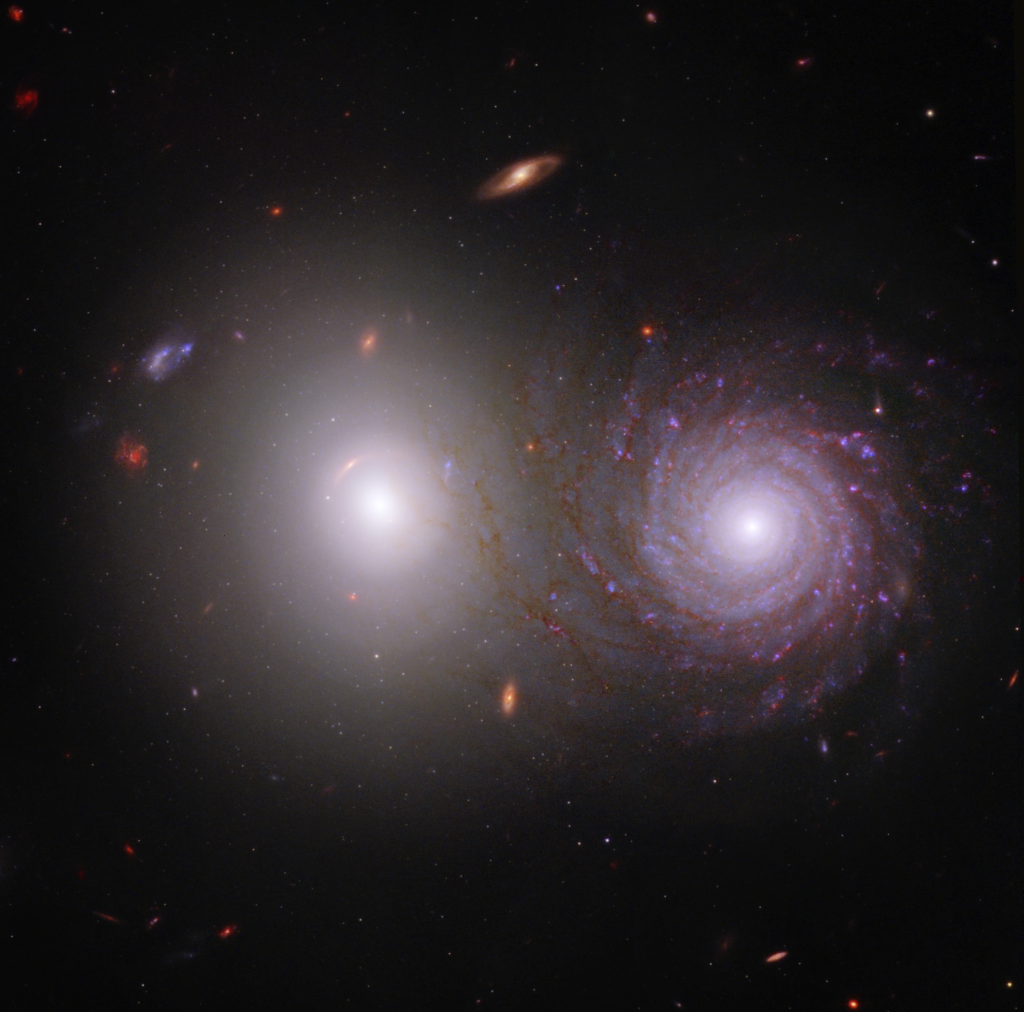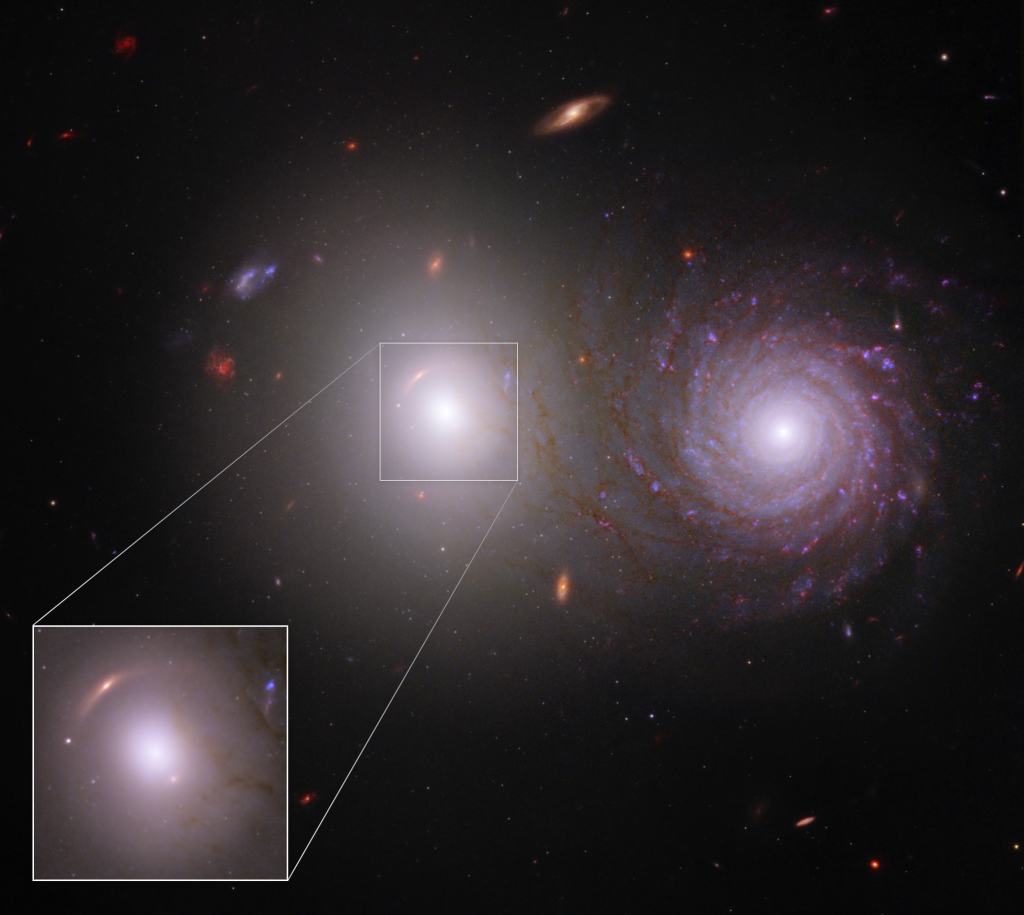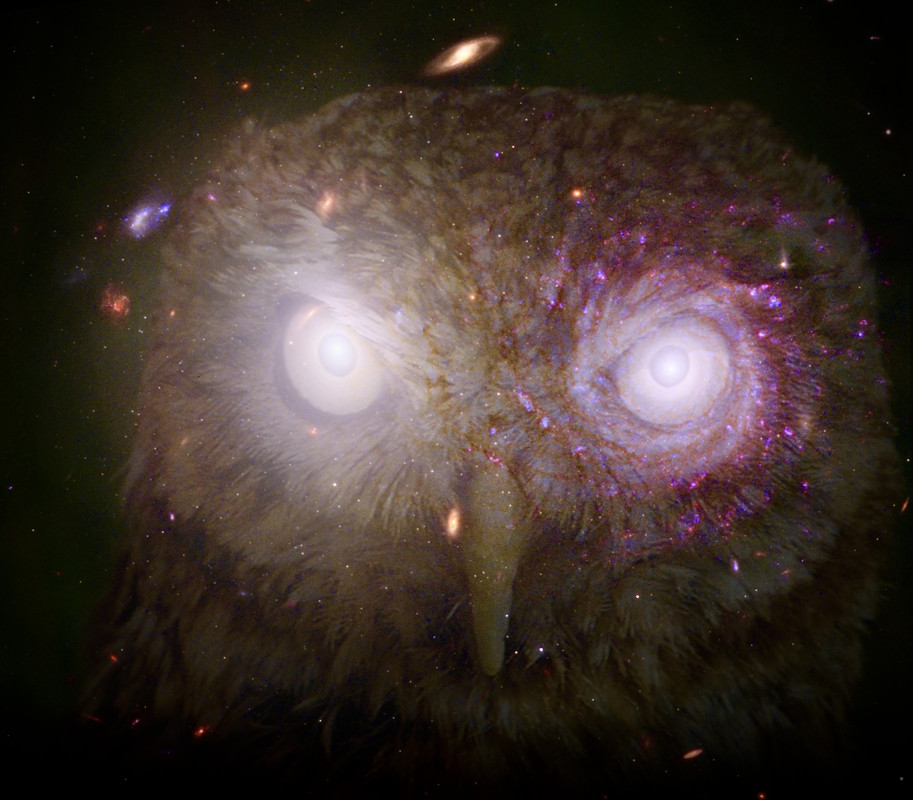
Posted on 10/06/2022 1:00:36 PM PDT by Red Badger
Editor’s Note: This post highlights data from Webb science in progress, which has not yet been through the peer-review process. Here, Webb interdisciplinary scientist Rogier Windhorst and his team discuss their observations.
“We got more than we bargained for by combining data from NASA’s James Webb Space Telescope and NASA’s Hubble Space Telescope! Webb’s new data allowed us to trace the light that was emitted by the bright white elliptical galaxy, at left, through the winding spiral galaxy at right – and identify the effects of interstellar dust in the spiral galaxy. This image of galaxy pair VV 191 includes near-infrared light from Webb, and ultraviolet and visible light from Hubble.
The majority of the image shows the black background of space. Two large, very bright galaxies dominate the center of the image. The elliptical galaxy at left is extremely bright at its circular core, with dimmer white light extending to its transparent circular edges. At right is a bright spiral galaxy. It also has a bright white core, but has red and light purple spiral arms that start at the center and turn clockwise going outward. They end in faint red and appear to overlap the elliptical galaxy at left. Throughout the scene are a range of distant galaxies, the majority of which are very tiny and red, appearing as splotches.

Researchers traced light that was emitted by the bright white elliptical galaxy on the left through the spiral galaxy at right. As a result, they were able to identify the effects of interstellar dust in the spiral galaxy. Webb’s near-infrared data also shows us the galaxy’s longer, extremely dusty spiral arms in far more detail, giving them an appearance of overlapping with the central bulge of the bright white elliptical galaxy on the left, though the pair are not interacting. In this image, green, yellow, and red were assigned to Webb’s near-infrared data taken in 0.9, 1.5, and 3.56 microns (F090W, F150W, and F356W respectively). Blue was assigned to two Hubble filters, ultraviolet data taken in 0.34 microns (F336W) and visible light in 0.61 microns (F606W). Read the full description and download the image files by clicking or tapping the image above. Credit: NASA, ESA, CSA, Rogier Windhorst (ASU), William Keel (University of Alabama), Stuart Wyithe (University of Melbourne), JWST PEARLS Team
“Webb’s near-infrared data also show us the galaxy’s longer, extremely dusty spiral arms in far more detail, giving the arms an appearance of overlapping with the central bulge of the bright white elliptical galaxy on the left. Although the two foreground galaxies are relatively close astronomically speaking, they are not actively interacting.
“VV 191 is the latest addition to a small number of galaxies that helps researchers like us directly compare the properties of galactic dust. This target was selected from nearly 2,000 superimposed galaxy pairs identified by Galaxy Zoo citizen science volunteers.
“Understanding where dust is present in galaxies is important, because dust changes the brightness and colors that appear in images of the galaxies. Dust grains are partially responsible for the formation of new stars and planets, so we are always seeking to identify their presence for further studies.
The majority of the image shows the black background of space. Two large, very bright galaxies dominate the center of the image. At right is a bright spiral galaxy. It also has a bright white core, but has red and light purple spiral arms that start at the center and turn clockwise going outward. The elliptical galaxy at left is extremely bright at its circular core, with dimmer white light extending to its transparent circular edges. A light white box overlays the elliptical galaxy and reappears at the bottom left, showing the area in a larger view. A stretched red arc appears above the elliptical galaxy at 10 o’clock and a red dot appears at 4 o’clock.

Above the white elliptical galaxy at left, a faint red arc appears in the inset at 10 o’clock. This is a very distant galaxy whose appearance is warped. Its light is bent by the gravity of the elliptical foreground galaxy. Plus, its appearance is duplicated. The stretched red arc is warped where it reappears – as a dot – at 4 o’clock. In this image, green, yellow, and red were assigned to Webb’s near-infrared data taken in 0.9, 1.5, and 3.56 microns (F090W, F150W, and F356W respectively). Blue was assigned to two Hubble filters, ultraviolet data taken in 0.34 microns (F336W) and visible light in 0.61 microns (F606W). Read the full description and download the image files by clicking or tapping the image above. Credit: NASA, ESA, CSA, Rogier Windhorst (ASU), William Keel (University of Alabama), Stuart Wyithe (University of Melbourne), JWST PEARLS Team
“The image holds a second discovery that’s easier to overlook. Examine the white elliptical galaxy at left. A faint red arc appears in the inset at 10 o’clock. This is a very distant galaxy whose light is bent by the gravity of the elliptical foreground galaxy – and its appearance is duplicated. The stretched red arc is warped where it reappears – as a dot – at 4 o’clock. These images of the lensed galaxy are so faint and so red that they went unrecognized in Hubble data, but are unmistakable in Webb’s near-infrared image. Simulations of gravitationally lensed galaxies like this help us reconstruct how much mass is in individual stars, along with how much dark matter is in the core of this galaxy.
“Like many Webb images, this image of VV 191 shows additional galaxies deeper and deeper in the background. Two patchy spirals to the upper left of the elliptical galaxy have similar apparent sizes, but show up in very different colors. One is likely very dusty and the other very far away, but we – or other astronomers – need to obtain data known as spectra to determine which is which.”
About the authors:
Webb interdisciplinary scientist Rogier Windhorst of Arizona State University and his team obtained the data used in this image from early results of the Prime Extragalactic Areas for Reionization and Lensing Science (PEARLS) JWST Guaranteed Time Observation (GTO) programs, GTO 1176 and 2738. Additional data from Hubble’s STARSMOG snapshot program (SNAP 13695) and GO 15106, were added. Jake Summers, also of Arizona State, performed the pipeline data reduction. The dust analysis was led by William Keel of the University of Alabama, while the Hubble data acquisition was led by Benne Holwerda of the University of Louisville in Kentucky. The detailed gravitational-lensing analysis was conducted by Giovanni Ferrami and Stuart Wyithe, both of the University of Melbourne, Australia and ASTRO 3D, Australia.
WEBB PING!..................

Was expecting lol
I miss the smart people that used to be on FR...
I know that it’s funny. It is also very unfair to the hard working engineers and techs who made it possible
Plus it lends itself to fun art!

~Easy
“It’s all turtles, all the way down. And all owls all the way up.”

~Easy
question: have any images been taken of anything “close” simultaneously or would it provide no benefit from a spacial perspective?
I like stuff you don’t have to think about!
😜😜🤣
Webb got some pretty cool pictures of Jupiter, that's relatively close.
It can't take any pictures of the back side of the moon because it's always too close to the sun, as I understand it. Webb can't be pointed anywhere near the sun.
I suppose sooner or later it will be used to get a some pics of an asteroid.
You mean like a "binocular vision" kind of thing?
I can't see that being of too much use, especially since Webb and Hubble make images in different wavelengths of light. OTOH, they could be used to get the range to objects within the solar system with a high degree of accuracy using triangulation. Maybe by so doing, the pair could get really accurate estimates of track and velocity for deciding whether an asteroid or meteor is going to hit Earth, at some future time.
Maybe it will get some pixs of Apophis in 2029...
Maybe Apophis will be inside JWSTs orbit...
Maybe it will be like the DART impact...
I just got to make it 7 more years...
thx, yes- a composite image
You mean like a “binocular vision” kind of thing?
I can’t see that being of too much use, especially since Webb and Hubble make images in different wavelengths of light. OTOH, they could be used to get the range to objects within the solar system with a high degree of accuracy using triangulation. Maybe by so doing, the pair could get really accurate estimates of track and velocity for deciding whether an asteroid or meteor is going to hit Earth, at some future time.
What does this have to do with the Clinton?s homely daughter?
A galactic pair?
A pair of what?
Just asking is all.
The headline created an interesting combination of words - “Webb Hubbell” was an infamous figure during the Clinton era when this forum was first started. Us “old timers” all though of him when seeing this headline at first glance.
Some conspiracy theories claim that Chelsea Clinton is actually Webb Hubbell’s daughter.
I don’t think that is a conspiracy theory. You can’t fake that kind of ugly!
I do wonder a little now why they named the two telescopes Webb and Hubble, but there’s some resemblance between Chelsea Clinton and Bill Clinton’s mother, Virginia Kelley, so I never put much stock in the rumors.
Ping!..................
Disclaimer: Opinions posted on Free Republic are those of the individual posters and do not necessarily represent the opinion of Free Republic or its management. All materials posted herein are protected by copyright law and the exemption for fair use of copyrighted works.